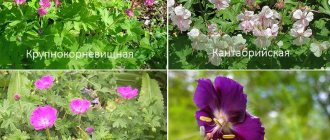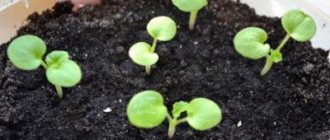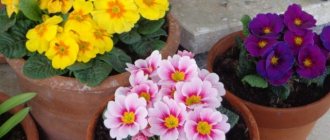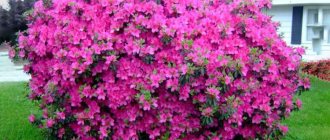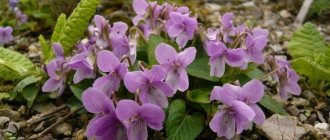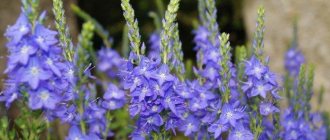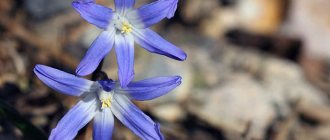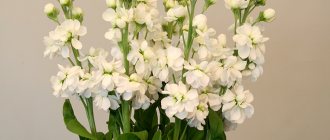Why do I grow geraniums in open ground?
Geranium is one of my favorite flowers, so it’s no secret that it brightens up my garden. Pelargonium is not only beautiful and bright, but also unpretentious in comparison with the “queen of the garden” rose. But when choosing a new variety, I study the description - the plant must be adapted to our climatic conditions.
perennial garden geranium
If you decide to grow geranium in your flower garden for the first time, I can recommend several varieties that you will definitely like:
- Ashy. I’ll start with the most unpretentious variety of geranium - it takes root well not only in the middle zone, but also in the northern regions. A low plant with ash-colored leaves - hence the name. The flowers themselves are bright pink with white centers. Ash pelargonium is preferred for decorating borders.
- Lugovaya. This geranium with the largest inflorescences is like blue saucers! I recommend this variety for open, sunny areas. Do not choose meadow geranium unless you can provide the plant with consistent, frequent watering.
- Himalayan. The most versatile pelargonium you will find in garden stores. It is used to decorate gazebos, plant them along borders, and on flower beds as a continuous “carpet.” Himalayan pelargonium blooms well and develops even in shaded areas. And the esthete’s eye will be delighted by its raspberry-lilac double blooms.
- Clark's geranium. An excellent choice for owners of plots in lowlands, where there is a high degree of humidity even in dry summers. Clark's Pelargonium is a plant with thin stems and beautiful large leaves. The petals of the inflorescences are soft blue, pleasant purple.
- Spotted. It grows into a large bush, rising 50 cm. The flowers are real snow-white or blue “bowls”. For spotted pelargonium to develop well, plant it in an open, well-lit area.
Propagation of perennial street geraniums
When comfortable conditions for growth are created, the ripened fruits of the plant spontaneously open and the seeds scatter far throughout the surrounding area. And in the spring, seedlings are found far from the main geranium plantings.
On the one hand, self-seeding allows you to update and unobtrusively change the appearance of the garden. On the other hand, when planted regularly, geraniums sprouting independently in the garden are not the most pleasant surprise. To avoid self-seeding, it is better to remove unripe fruits.
If the grower is going to use his own seeds for sowing, he will have to solve a difficult problem. Drying ripe fruits immediately open, and unripe seeds may not produce the desired shoots. Therefore, in advance, the tops of flower stalks with fruits are hidden in small canvas bags and tied at the bottom so that the seeds remain inside.
Due to the hassle of the process and the unguaranteed production of seedlings, seeds for propagating garden perennial geraniums are rarely used. It is much more effective and easier to get a new plant by dividing an adult bush.
When can you plant geraniums in open ground?
I plant geraniums in an open flower garden as soon as the threat of frost on the soil has passed. Make sure that the soil is thoroughly warmed up to 15˚ C minimum. In most Russian regions, planting pelargonium can be safely planned for the month of May, but I will still clarify the information on climatic zones:
- Middle lane. As soon as daytime temperatures remain stably around 17-20˚ C, and night temperatures no longer drop below 9˚ C, plant.
- Southern regions. If the weather is warm and pleasant, plan to plant for the last week of April.
- Ural, Siberia. I advise residents of these regions to think about planting pelargonium in unprotected soil no earlier than the 2nd half of May. Be sure to check the long-range weather forecast to ensure there are no unexpected frosts. I plan planting activities for the beginning of prolonged rains - at this time pelargonium takes root faster and better.
Although geranium is a rather unpretentious plant, I plant it in the evening, after sunset. The burning rays of the sun will not benefit a plant weakened by the procedure.
planting geraniums in open ground
Diseases and pests
With proper care, garden pelargonium acquires natural resistance to infectious diseases and pests. However, it can be affected by:
- Rot is a bacterial infection that is a consequence of violations of agricultural practices. Signs: the appearance of vague dark spots on leaf blades and shoots. Remedy: cut off all damaged elements of the bush and treat with complex fungicides.
- Tomato wilt, which is characterized by the appearance of spots that look like rings. In case of minor infection, the diseased elements are removed and burned, and the bush is sprayed with chemicals. In case of severe damage, the bush is removed from the flowerbed and burned, and the soil is watered with fungicides.
Of the possible pests, aphids, whiteflies and caterpillars most often settle on geraniums. The first two troubles are removed by spraying with an insecticide. To combat the caterpillar, it is advisable to use a mechanical method - to collect it manually.
Types of planting material and its preparation
Geraniums are planted in several ways - I will tell you in detail how to prepare this or that variety for planting:
- Cuttings. Before planting in a permanent place, such seedlings must first be prepared. I harden them - I take them out onto the balcony, onto the open terrace, so that they get used to unprotected conditions. Before transplanting, I keep it in any of the popular growth stimulants. I dust the cut moistened with the solution with ash. If there is no ash, use pharmaceutical activated carbon powder.
- Seeds. Another popular method of growing geraniums. Since sowing seeds and caring for sprouts is a more labor-intensive procedure, this method is chosen much less often. The first shoots appear after 2 weeks; subsequent development largely depends on the plant variety and its growing conditions. I recommend sowing seeds in open ground no earlier than the last weeks of May. The seedlings will be weak and therefore need thinning. The minimum distance between the sprouts is 5 cm. Then, when they get stronger, transplant them at intervals of 40 cm from each other. In the year of sowing, seed pelargonium will not bloom. Another option is to plant the seeds as seedlings, and then transport them to a permanent place in the garden. I do not recommend this method of propagation if there are forecasts that the next winter will be frosty - the plants may not survive it.
Features of the plant
Geraniums first settled in the garden back in the days of ancient Greece. Gardeners noticed its resemblance to a bird's beak and nicknamed it “geranion,” which means crane. There is a legend that crops with openwork leaf blades were cultivated in the gardens of Dioscorides. It was from there that the plant moved to European countries. Since the Middle Ages, people have noticed the healing properties of the culture and began to use it in medicine.
An amazing plant appeared in Rus' several centuries ago. Today, perennial garden geranium (photo) has more than 600 species.
In nature, geranium grows on open edges of deciduous and coniferous forests. It can often be found on river banks and mountain glades. Perennial garden pelargonium has retained most of the characteristics of a wild flower and acquired its own characteristics:
- Adaptability to adverse weather conditions, hot summers and harsh winters.
- Refinement and sophisticated decorativeness.
- The flowers have become brighter colors, and some varieties bloom twice during the growing season.
- The foliage has become more variegated, and the flowers are large and double.
Varieties of garden geranium differ from each other in size and shades of flowers. There are varieties with a color that does not exist in nature. As a rule, pelargonium flowers have 5 petals with characteristic veins that decorate the inflorescences. The leaf plates have also changed. They are able to decorate the garden even when the flower stalks are withering. The leaves have different colors and variegated tones. Shape – from round to dissected.
Preparing the soil and planting geraniums in open ground
In addition to the planting material itself, I prepare the flower bed. It is best to choose a zone for geranium:
- with an airy, soft, light substrate;
- without direct sunlight (depending on the variety);
- with warmed and pre-moistened soil - great if there were heavy rains before planting.
Flower beds for pelargonium need the following treatment:
- In the fall, I carefully dig it up, simultaneously applying complex mineral fertilizer.
- Before directly planting pelargonium, I slightly acidify the soil. You can use both oxalic acid, citric acid, and iron sulfate for these purposes.
- Geranium prefers drained posts. So I try to loosen the soil very, very carefully. If it has managed to compact well over the winter, it is better to start by digging it onto the bayonet of a shovel.
- Spread a 5-10 cm layer of rotted compost over the surface of the already prepared flower bed. Mix it with garden soil.
- Now is the time to make holes for geranium seedlings - a 25-centimeter depth is enough. If you are already planting large bushes, make sure that the root system both in length and width fits freely in the hole. Otherwise, the plant will not grow and develop at all.
- I fill the bottom of each hole with a 1 cm layer of peat-sand-compost mixture.
The transplantation of seedlings itself follows the following scheme:
- Place the previously prepared bush and the cutting into the hole. If it is a bush, inspect its root shoots for damage.
- Sprinkle with soft fertile soil, lightly compact the substrate at the base of the plant stem.
- Pour water heated under the sun - generously, but not so much that a “swamp” remains.
- If you are replanting more than one cutting or bush, then plan planting according to the following scheme: between cuttings - at least 20 cm, between mature and developed bushes - already about 60 cm.
Disembarkation
When planting cuttings or divisions, it is necessary to harden the young plants a week before transferring them outside .
For this purpose, they are taken outside every day and left at the landing site or in conditions as close as possible to garden conditions.
Pots of flowers can be left overnight if a significant drop in temperature is not expected.
Plants hardened in this way after transplantation adapt much faster and easier to new living conditions, which will allow them to bloom quickly and abundantly.
Pelargonium prefers light soils. Therefore, to facilitate plant adaptation, sand and fertilizers are added to the holes. The planting depth in open areas should be the same as in a pot.
After transferring the flowers, the soil around them is mulched, and the soil is acidified with a light solution of citric acid at the rate of 1 tsp. dry product per 3 liters of water.
The size of the prepared hole should be slightly larger than the diameter of the pot in which the planting material was located. This is done in order to protect the root system during transfer.
Site design and photos
Pelargonium bushes are compact in size, so they can be used as border plants planted along garden paths. This flower also looks beautiful in potted arrangements or in larger flowerpots.
Attention! This placement controls the growth of the root system, which makes it easier to move the plants back into the house.
Look at the photo to see what the plant looks like on the site:
Video about planting pelargonium on a site:
How to care for geraniums in open ground
I started the post by calling geranium an unpretentious plant. Having learned how easy it is to care for it in an open flowerbed, you will probably share my opinion.
Watering
This flowering plant needs stable, systematic and fairly abundant watering. Do not forget about the “golden mean” rule - water should not stagnate on the surface of the flowerbed. Pelargonium requires root watering - do not allow liquid to get on the leaves. If water constantly drips onto the green part of the plant, the leaves will begin to fade over time, or even rot.
I water my geranium plantings every day. If you do not have this opportunity, I recommend mulching the flowerbed. Mulch will prevent the liquid from evaporating, which means less water procedures will be required.
watering geraniums
Top dressing
The greatest attention should be paid to spring feeding of geraniums:
- Nitrogen compounds are the first fertilizer. Stimulation of further development of the flower, growth of thick and beautiful green mass.
- Complex composition - second fertilizer (after a month). The nutrient mixture must contain nitrogen, potassium, phosphorus components, as well as microelements.
Fertilizing geraniums in the summer months is a simple, but again regular, procedure. No special fertilizing is required: for example, from time to time I add new peat or compost to the flowerbed.
Features of feeding pelargonium also depend on the plant variety and its location. So, if a geranium grows on a hill, it will need less nutrition than flowers growing on flat areas.
Trimming
With the onset of abundant flowering, I try to trim off the dried flowers. This simple measure will not allow the plant to lose its beautiful appearance and will help prolong its luxurious flowering.
In the fall, I prune pelargonium bushes - I simply remove dried branches and green matter. This is necessary in order to stimulate the development of new shoots next spring.
Prevention of diseases and pests
As for diseases and enemies, they overcome the plant, mainly when the gardener violates the rules for caring for the flower. Among the pests, whiteflies and aphids prefer Russian geranium. If there are not many uninvited guests, you can save the flower from them by spraying with a soap solution. In cases where the pest invasion is serious, it makes sense to arm yourself with special means like Iskra or Fitoverma.
As for infectious diseases, pelargonium suffers from the following diseases:
- Fungal infections. You can easily understand their distribution by noticing gray spots and inclusions on the leaves and shoots of geranium plantings. I use store-bought antifungal chemicals.
- Edema. Chlorosis develops on the leaves and characteristic bubbles appear. Be sure to remove and burn affected shoots and leaves. Otherwise, it will spread to all plants.
It is, of course, better to prevent problems than to eliminate them. Therefore, pay attention to simple prevention:
- Do not plant garanium in cold, unheated soil - wait until the ground warms up. Be sure to dig, loosen and drain the substrate.
- Although geraniums need good watering, only water them when necessary. Do not plant pelargonium next to very moisture-loving plantings.
- Using disinfected tools, promptly remove and burn leaves affected by infections and pests.
- Do not forget about periodic sanitation of the flower garden and removal of weeds.
- It is better to plan watering plants in the morning, before sunrise.
- When using water procedures, carefully ensure that the liquid does not splash onto the leaves.
Can I plant outside?
Pelargonium will harmoniously add bright notes to any landscape design and diversify it with a riot of colors. This flower can and should be planted in a flower bed. Only for this it will be necessary to meet a number of conditions, without which the flower will not be able to adapt to the area.
We should not forget that pelargonium is a guest from southern latitudes. Therefore, it does not tolerate cold and sharp drops in ambient temperature.
The necessary conditions
A member of the Geraniaceae family may be herbaceous or subshrub . It is cultivated as a perennial. But based on its heat dependence, there are some subtleties of cultivation.
In order for pelargonium to please the eye with its bright colors all summer, it requires soil with a low pH level. And a weak root system will feel great in nutritious and slightly loose soil
Absolutely all varieties of this plant are skeptical about direct sunlight.
Therefore, to create comfortable conditions, diffused sunlight will be an important factor ; partial shade should not be neglected.
The optimal air temperature that pelargonium can easily tolerate is considered to be +20 degrees. This suggests that you should be concerned about a slight darkening of the area.
Despite the completely unpretentious nature of this flower, it does not tolerate frequent transplants very well. Therefore, the choice of place for its growth must be approached responsibly.
How does garden geranium propagate?
Geranium propagates in several ways. There is a persistent stereotype that pelargonium is definitely a houseplant. But in reality this is not so - it feels great in the garden.
Germination of seeds
As I wrote earlier, gardeners are not very fond of this method because of its complexity. Firstly, small and weak sprouts need special conditions and require long and careful care. Secondly, don’t overlook it - they have already withered from excess moisture or withered from the heat and stuffiness. Please note that only biennial geraniums can be grown from seeds.
Rooting cuttings
Perhaps the most common method of propagating geraniums - at least among Russian gardeners. The planting material is cuttings from old geranium plantings - just cut off the upper part of the pelargonium stem 15 cm long. It’s great if the cuttings have several developed leaves. Agronomists agree that it is the propagation of geraniums by cuttings that makes it possible to obtain viable and healthy seedlings.
Dividing the bush
Another way to propagate a plant is by divisions. This method is good because pelargonium is covered with flowers within 3 weeks after planting. For division, you can use ordinary homemade geranium: carefully remove the plant from the pot, divide it into several divisions - each of them should have its own stem.
geranium propagation
Transplanting geraniums
As a rule, most varieties survive the winter well - you just need to trim them and cover them with a sufficient thickness of mulch. But, for example, royal geranium cannot be called winter-hardy. If winters are too severe in your region, garden geraniums can be replanted in a pot during the cold season and taken home. In the warmth, it will continue to delight with flowering in winter.
If you intend to transplant the geranium into a pot for the winter, be sure to lay drainage at the bottom and prepare a nutritious and light soil mixture. It is better to dig up the plant early, before frosts begin on the soil. Make sure that the root system fits freely in the prepared pot, without twisting or deforming.
Before bringing the transplanted geranium into a warm place, keep the pelargonium for a week on the veranda or open balcony. The flower needs time to get used to the new warm conditions.
Plan replanting into open ground both in spring and summer - the main condition is that the soil is thoroughly warmed up. But under no circumstances plan work if pelargonium is blooming! Postpone the procedure to a later date, otherwise there is a high risk that the plant will die.
Geranium is a beautiful and unpretentious inhabitant of the garden bed. Choose a convenient method of propagation, planting, as well as a variety that will be comfortable in the conditions of your garden. Planting itself, as well as subsequent care of pelargonium, does not cause difficulties even for novice flower growers and gardeners.
Useful properties of geranium
All types of garden geranium are used as medicinal herbs. It is made from:
- decoctions;
- tinctures;
- oil.
The roots and vegetative mass of the plant have medicinal properties. Since there are many active compounds that help a person. The famous geranium oil, which contains geraniol, is obtained from it. In addition to this, there are many useful connections:
- Glucose.
- Fructose
- Saponins.
- Large amount of tannins.
- Carotenes.
- Various vitamins.
And many more different substances. Preparations made from this oil have anti-inflammatory, antiviral and hemostatic properties. The drugs are calming and have a good effect on human performance.
An elixir is made from the dried flowers of white geranium, used for nervous overexcitation and stress.
The roots and vegetative mass are harvested and dried in the shade. The greens are cut during growth and flowering, and the roots are harvested in the fall. After digging up the roots, they are washed, cut and dried in an oven at a temperature of 60 degrees. The dried herb retains its medicinal properties for one and a half years.
